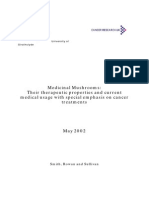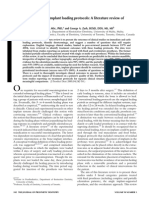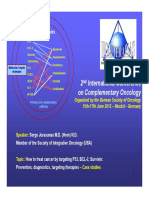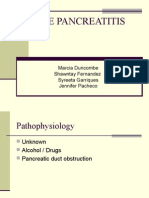0 ratings0% found this document useful (0 votes)
48 viewsK7-Ethical Decision Making
K7-Ethical Decision Making
Uploaded by
Jamali GagahThis document discusses ethical decision making in medicine. It outlines four perspectives on ethics: the Hippocratic approach which focuses on beneficence and non-maleficence, the principles approach which also considers autonomy and justice, the interpretative approach which examines patients' experiences and motivations, and the collaborative approach which emphasizes partnership between physicians and patients. It also presents a case study of a patient consulting her gynecologist about abdominal pain and analyzes the case from these ethical lenses. The document concludes that ethical decision making is a process involving both medical facts and patients' and physicians' values, and the goal should be collaborative decisions that improve patient well-being and align with their goals.
Copyright:
© All Rights Reserved
Available Formats
Download as PPT, PDF, TXT or read online from Scribd
K7-Ethical Decision Making
K7-Ethical Decision Making
Uploaded by
Jamali Gagah0 ratings0% found this document useful (0 votes)
48 views12 pagesThis document discusses ethical decision making in medicine. It outlines four perspectives on ethics: the Hippocratic approach which focuses on beneficence and non-maleficence, the principles approach which also considers autonomy and justice, the interpretative approach which examines patients' experiences and motivations, and the collaborative approach which emphasizes partnership between physicians and patients. It also presents a case study of a patient consulting her gynecologist about abdominal pain and analyzes the case from these ethical lenses. The document concludes that ethical decision making is a process involving both medical facts and patients' and physicians' values, and the goal should be collaborative decisions that improve patient well-being and align with their goals.
Copyright
© © All Rights Reserved
Available Formats
PPT, PDF, TXT or read online from Scribd
Share this document
Did you find this document useful?
Is this content inappropriate?
This document discusses ethical decision making in medicine. It outlines four perspectives on ethics: the Hippocratic approach which focuses on beneficence and non-maleficence, the principles approach which also considers autonomy and justice, the interpretative approach which examines patients' experiences and motivations, and the collaborative approach which emphasizes partnership between physicians and patients. It also presents a case study of a patient consulting her gynecologist about abdominal pain and analyzes the case from these ethical lenses. The document concludes that ethical decision making is a process involving both medical facts and patients' and physicians' values, and the goal should be collaborative decisions that improve patient well-being and align with their goals.
Copyright:
© All Rights Reserved
Available Formats
Download as PPT, PDF, TXT or read online from Scribd
Download as ppt, pdf, or txt
0 ratings0% found this document useful (0 votes)
48 views12 pagesK7-Ethical Decision Making
K7-Ethical Decision Making
Uploaded by
Jamali GagahThis document discusses ethical decision making in medicine. It outlines four perspectives on ethics: the Hippocratic approach which focuses on beneficence and non-maleficence, the principles approach which also considers autonomy and justice, the interpretative approach which examines patients' experiences and motivations, and the collaborative approach which emphasizes partnership between physicians and patients. It also presents a case study of a patient consulting her gynecologist about abdominal pain and analyzes the case from these ethical lenses. The document concludes that ethical decision making is a process involving both medical facts and patients' and physicians' values, and the goal should be collaborative decisions that improve patient well-being and align with their goals.
Copyright:
© All Rights Reserved
Available Formats
Download as PPT, PDF, TXT or read online from Scribd
Download as ppt, pdf, or txt
You are on page 1of 12
ETHICAL DECISION MAKING
DIVISI BIOETIKA DAN MEDIKOLEGAL
FK USU
2009
Physicians are able to approach patients
and their families and friends in intricate
ways, bodily, emotionally, psychologically
and socially.
This is based on the publics trust in the
competency, expertise and ethics
embodied by the medical profession.
Medicine shows a long history of such
solemn pledges, embodied in oaths and
conducts of codes.
This expresses the fact that physician
have oppurtunities to intervence with the
patient: inspecting the body, asking
intimate questions, and rearranging the
lives of patients, of their families and of
society.
This privileged position of the physician
requires a high standard of
professionalism, competence and ethical
attitude and values
Ethical decision making in practise is a complex
process, such as :
A patient visits the gynecologist because of
abdominal pain . She says that she cannot
explain the pain, because her uterus has been
extirpated. The physician ask various question :
How long does she have these complaints? Is
the pain always on the same place? The patient
responds and report that she has moreover
constipation. Then, the gynecologist ask if she is
worrying. The patient says that she is afrais of
cancer. The gynecologist proposes an internal
examination.
But the patient reacts negatively. She doubts
whether an internal examination provides
enough information and prefer a laparascopy.
The physician states that each methods has its
advantages and disadvantages and that he has
to examine her first in order to be able to decide
on further steps. After the examination he
proposes to consult a dietician, to help to relieve
the constipation. He repeat his objections
againts such a dramatic investigation as a
laparoscopy. Moreover, he emphasizes that
such an examination does not provide full
certainty. When henproposes that a laparoscopy
can always be performed later on, the patient
agrees with his proposal.
How would we assess such a case? It
depends on the ethical perspective one
takes. Feeling of easiness or uneasiness
in decision making in medical practise
depend not only on whether the presented
case notifies a rational, efficient and
technically adequate course of action, but
also on whats should have happened.
That is, w/hether it is good what has
happened
Some Ethical Perspectives
1. The Hipocratic-biomedical approach
The physician is attentive and careful for the
good of the patient. The guiding principles are
beneficence, doing good, and nonmalificence,
doing no harm. The physician has to decide
what responsible medical acting is and
objectify what the best interest of the patient is
: doctor knows best . This paternalistic
tradition is still very influential in medicine and
despite many objection helpful in various
circumstances, such as emergency situations
or with incompetent patient
2. The principle ethics approach
Next to the principles of beneficence and
nonmaleficence, the principles of
autonomy and justice become dominant.
If the best interest of the patient is at
stake, who else than the patient him or
her self can and should desice what is
the best interest? Decisions of
physicians need to be based on the
informed consent of the patient.
3. The interpretative ethics approach
Interpretative approaches do start from
Aristotelian tradition that in practise human
being, patients and professionals are already
oriented on the good and the good life. The
moral experiences and motivations of the
concerned persons are the starting point: what
do they find evident and what do they find
difficult? What do they strife for? What do they
want to avoid. The case is about more than
only autonomy or doing good (or do no harm),
it is a conversation about fear, uncertainty and
prospects.
4. Collaborative or dialogical ethics approach
This approach integrates elements of the
previous approach, stressing that medical
practise is an encounter between persons,
each with a set of values, preferences and
perspestives, which have to evolve and to
interact. Collaborative decision making places
emphasis on the fact that physician and patient
should work together in medical decision
making and ultimately strive for same goal:
putting to use medical knowledge and
techniques to improve the well-being of the
patient in comformity with his or her own
values and life plan.
Conclusions
Ethical decision making is not a single
event, but a process.
Medical facts and technique express as
much values and preferences of
physicians as patients enter the process
with their values and preferences.
Values and preferences are not only in the
heads of physician s, they are embedded
in the routines, organization, protocols and
guidelines of everyday hospital practice.
Patient's values, goals and preferences
should guide the decision making process,
but this requires more than 'better talking,
it also requires changes in attitude,
perspectives as well as institutional and
organizational arregements.
Ethical decision making is not ethicists
telling physicians how to do the trick, but a
practice in which physicians and patients,
in collaboration with other health care
workers, put in their expertise, their skills
and their values and moral experiences.
You might also like
- Health Education: Evidenced Based PracticesDocument58 pagesHealth Education: Evidenced Based PracticesChantal Raymonds90% (41)
- Ethical Issues in PhlebotomyDocument6 pagesEthical Issues in Phlebotomylisalov100% (1)
- Theory and Application of Law and Ethical Reasoning in Nursing Practice - EditedDocument15 pagesTheory and Application of Law and Ethical Reasoning in Nursing Practice - EditedKristin Muriuki100% (1)
- Ethico-Moral Responsibility of Nurses: EuthanasiaDocument39 pagesEthico-Moral Responsibility of Nurses: EuthanasiaEdna ChanNo ratings yet
- Legal & Ethical Issues in PICUDocument13 pagesLegal & Ethical Issues in PICUrittika dasNo ratings yet
- The 4-Box Method of Clinical Ethics-Prof HakimiDocument14 pagesThe 4-Box Method of Clinical Ethics-Prof HakimibloadyroarNo ratings yet
- Ethics Case StudyDocument9 pagesEthics Case Studyapi-305128971100% (1)
- Recommendation LetterDocument5 pagesRecommendation LetterSui GenerisNo ratings yet
- Fellowship Directory (5-4-21)Document32 pagesFellowship Directory (5-4-21)twice againNo ratings yet
- Drug Induced Renal DisorderDocument50 pagesDrug Induced Renal DisorderYv SantoshNo ratings yet
- Charina Aubrey Riodil Bsn-IiDocument3 pagesCharina Aubrey Riodil Bsn-IiCharina AubreyNo ratings yet
- Legal and Ethical IssuesDocument22 pagesLegal and Ethical IssuesPratima Karki100% (1)
- Dr. Mohamed Mosaad Hasan MD, MPH, CPHQ, CPPS, GbssDocument48 pagesDr. Mohamed Mosaad Hasan MD, MPH, CPHQ, CPPS, GbssKristine Marie PateñoNo ratings yet
- Unit 5-7Document38 pagesUnit 5-7Lovelights ZamoraNo ratings yet
- Ethical Decision Making in Critical CareDocument5 pagesEthical Decision Making in Critical CarePALMA , JULIA A.No ratings yet
- Evidence Based Practice Lec 9Document38 pagesEvidence Based Practice Lec 9Nk Prince100% (1)
- Ethico Moral Responsibility of Nurses and Basic Nursing Jurisprudence Updated 2024 (20241006194820)Document20 pagesEthico Moral Responsibility of Nurses and Basic Nursing Jurisprudence Updated 2024 (20241006194820)r8yqxcmdrxNo ratings yet
- Approach To The PatientDocument29 pagesApproach To The Patientemmanueluwakwe2022No ratings yet
- Clinincal EthicsDocument20 pagesClinincal EthicspremsstrNo ratings yet
- Ethical Issues in Palliative Care: 13 APHC, Surabaya-IndonesiaDocument52 pagesEthical Issues in Palliative Care: 13 APHC, Surabaya-IndonesiaBayu PermanaNo ratings yet
- Ethical Dimension of Nursing Practice WordDocument6 pagesEthical Dimension of Nursing Practice Wordpink096No ratings yet
- Applied Medical EthicsDocument25 pagesApplied Medical EthicsSuja LakshmananNo ratings yet
- EditKaidah Dasar Bioetik &Document49 pagesEditKaidah Dasar Bioetik &Chimul Lavigne 'L'No ratings yet
- Ethical Issues in Pallative CareDocument49 pagesEthical Issues in Pallative CareDagim KebedeNo ratings yet
- Lecture 1Document34 pagesLecture 1hazharomar958No ratings yet
- Health Care Ethics 2024Document13 pagesHealth Care Ethics 2024celestineNo ratings yet
- Patient Centerd CareDocument42 pagesPatient Centerd Care21910589No ratings yet
- Regodos Ethical IssuesDocument3 pagesRegodos Ethical IssuesIan Cyrus RegodosNo ratings yet
- Introduction To Medical Ethics: Presenter: DR Purva Shoor Assistant Professor Community MedicineDocument33 pagesIntroduction To Medical Ethics: Presenter: DR Purva Shoor Assistant Professor Community MedicineDr purva ShoorNo ratings yet
- Module 5Document31 pagesModule 5Ogie Rose BanasanNo ratings yet
- 1 - Ethical IssuesDocument33 pages1 - Ethical IssuesDaniyal Azmat100% (1)
- Midterm: Relevant Ethico-Legal Guidelines in Conducting Health AssessmentDocument28 pagesMidterm: Relevant Ethico-Legal Guidelines in Conducting Health AssessmentLorraine CayamandaNo ratings yet
- NCM108 Module 1-CDocument9 pagesNCM108 Module 1-Cmirai desuNo ratings yet
- (P1) BioethicsDocument100 pages(P1) BioethicsGeralyn KaeNo ratings yet
- American Nurses Association Code of EthicsDocument2 pagesAmerican Nurses Association Code of Ethicsagung sedanaNo ratings yet
- Ethics in Medical PracticeDocument35 pagesEthics in Medical PracticeMohammed AadeelNo ratings yet
- Ethical Dilemma NoteDocument36 pagesEthical Dilemma NoteroseNo ratings yet
- Practice Teaching Ethical and Legal IssueDocument12 pagesPractice Teaching Ethical and Legal Issuejyoti singhNo ratings yet
- Com Skillz Assignment DocumentDocument4 pagesCom Skillz Assignment Documentchulumaxwell5No ratings yet
- Code of Ethical ConductDocument19 pagesCode of Ethical ConductNeha VermaNo ratings yet
- Lect.3 Ethical Dilemma and Ethical Decision Making in NursingDocument21 pagesLect.3 Ethical Dilemma and Ethical Decision Making in NursingHusain Tamimie100% (4)
- BioetikaDocument49 pagesBioetikaErenJelaluNo ratings yet
- Dr. Leonida T. Zulueta R.N.,M.A.NDocument11 pagesDr. Leonida T. Zulueta R.N.,M.A.NMilagros AgustinNo ratings yet
- Ethics For EMS ProvidersDocument46 pagesEthics For EMS ProvidersPaulhotvw67100% (4)
- CHNDocument3 pagesCHNAllaine CerbitoNo ratings yet
- Etika Profesi Dan Hukum Kesehatan: Fikri Mourly WahyudiDocument23 pagesEtika Profesi Dan Hukum Kesehatan: Fikri Mourly WahyudiArya MuhammadNo ratings yet
- NHSFPX4000 Assessment 3 Applying Ethical PrinciplesDocument6 pagesNHSFPX4000 Assessment 3 Applying Ethical PrinciplesNursFpx-4000-4900No ratings yet
- How Doctors WantDocument16 pagesHow Doctors WantErwin WahidNo ratings yet
- CAMDocument6 pagesCAMDrogNo ratings yet
- Two Ethics Case ScenariosDocument3 pagesTwo Ethics Case ScenariosEguia NielNo ratings yet
- EthicsDocument107 pagesEthicsaa zzNo ratings yet
- Week 3 PATIENTS RIGHTS AND RESPONSIBILITIES 19-20Document32 pagesWeek 3 PATIENTS RIGHTS AND RESPONSIBILITIES 19-20maha abdallahNo ratings yet
- Bioethics: Bachelor of Science in NursingDocument6 pagesBioethics: Bachelor of Science in NursingSherinne Jane Cariazo0% (1)
- Lillian Mohambi NDY Homework Ethical Dilemmas in NursingDocument3 pagesLillian Mohambi NDY Homework Ethical Dilemmas in NursinglillyNo ratings yet
- Legal and Ethical Issues in GeriatricsDocument5 pagesLegal and Ethical Issues in GeriatricsStephy Sojan75% (4)
- BIOETIKADocument49 pagesBIOETIKAVina Subaidi100% (1)
- Ethics in MedicineDocument24 pagesEthics in Medicinekavi priyaNo ratings yet
- Ethical Principles in Community Health NursingDocument24 pagesEthical Principles in Community Health Nursingjansanmathew33% (3)
- HCE Module 1 - Introduction To Health Care EthicsDocument4 pagesHCE Module 1 - Introduction To Health Care EthicsAlaiza AvergonzadoNo ratings yet
- The 4 Box Method - Practical ApproachDocument39 pagesThe 4 Box Method - Practical ApproachramwshNo ratings yet
- A. Virtues Exemplified by The Ethical Physician: CompassionDocument6 pagesA. Virtues Exemplified by The Ethical Physician: CompassionIvanFernandesNo ratings yet
- Course Unit 4 Ethical Principles and Relevant Principles in Health CareDocument6 pagesCourse Unit 4 Ethical Principles and Relevant Principles in Health Careheyybestie76No ratings yet
- Medical Ethics: A Physician's Guide to Clinical MedicineFrom EverandMedical Ethics: A Physician's Guide to Clinical MedicineNo ratings yet
- Etika Hub DR - PasienDocument27 pagesEtika Hub DR - PasienJamali GagahNo ratings yet
- K6-Ethical Aspect in Physicians and ColleaguesDocument15 pagesK6-Ethical Aspect in Physicians and ColleaguesJamali GagahNo ratings yet
- K5-Ethical Aspect of Physician-Patient and Physician-Society RelationshipDocument29 pagesK5-Ethical Aspect of Physician-Patient and Physician-Society RelationshipJamali GagahNo ratings yet
- Bs Profesionalisme Kedokteran Mencegah Malpraktik Dalam KontDocument38 pagesBs Profesionalisme Kedokteran Mencegah Malpraktik Dalam KontJamali GagahNo ratings yet
- Ankle Sprain: Wan Fadzlin BT Wan Shukry Sports 4242132014Document20 pagesAnkle Sprain: Wan Fadzlin BT Wan Shukry Sports 4242132014olieynshukryNo ratings yet
- CLEA 2015 (ASIA-INDIA) AppellantsDocument30 pagesCLEA 2015 (ASIA-INDIA) AppellantsAmol Mehta86% (7)
- Why Physicians Should Not Accept Money From The Pharmaceutical Industry, by Carl ElliottDocument6 pagesWhy Physicians Should Not Accept Money From The Pharmaceutical Industry, by Carl ElliottCarl Elliott100% (1)
- Defect Sheet TemplateDocument18 pagesDefect Sheet TemplatesyahidatulNo ratings yet
- Medicinal Mushrooms Their Therapeutic Properties and Current Medical Usage With Special Emphasis On Cancer Treatments 2002Document276 pagesMedicinal Mushrooms Their Therapeutic Properties and Current Medical Usage With Special Emphasis On Cancer Treatments 2002lordraffael100% (1)
- A Case Report of Acute Lymphoblastic Leukemia - An Ayurvedic ApproachDocument4 pagesA Case Report of Acute Lymphoblastic Leukemia - An Ayurvedic ApproachSrikanth BallamudiNo ratings yet
- Jay Ar Resume-UpdatedDocument4 pagesJay Ar Resume-UpdatedBrandy JacksonNo ratings yet
- TomographyDocument562 pagesTomographyCirnu Alina92% (13)
- Agnus CastusDocument4 pagesAgnus CastusSifatullah SiddiqiNo ratings yet
- Development, Implementation and Impact of Simple Patient Safety Interventions in A University Teaching HospitalDocument6 pagesDevelopment, Implementation and Impact of Simple Patient Safety Interventions in A University Teaching HospitalMariale OrdóñezNo ratings yet
- AFP CalsetDocument1 pageAFP CalsetModestusNo ratings yet
- Etiologi Dan Gejala Klinis Pneumonia RevisiDocument15 pagesEtiologi Dan Gejala Klinis Pneumonia Revisiazis purwantoNo ratings yet
- Neurología: Letters TO THE EditorDocument2 pagesNeurología: Letters TO THE EditorMahda Rizki LianaNo ratings yet
- Curriculum Vitae: Personal InformationDocument14 pagesCurriculum Vitae: Personal InformationandreayabutgNo ratings yet
- Smile Makeover ContentDocument2 pagesSmile Makeover ContentjaromireNo ratings yet
- Prevalence of Cusp Fractures in Teeth Restored With Amalgam and With Resin-Based CompositeDocument6 pagesPrevalence of Cusp Fractures in Teeth Restored With Amalgam and With Resin-Based CompositePablo BenitezNo ratings yet
- Liu2017Document9 pagesLiu2017Stery OrohNo ratings yet
- Plant-Derived Natural Products in Drug Development 7: Balandrin E T A LDocument5 pagesPlant-Derived Natural Products in Drug Development 7: Balandrin E T A LELIANA HERNANDEZ PEREZNo ratings yet
- Slide TelenursingDocument16 pagesSlide TelenursingSoedjar WaeNo ratings yet
- OT Table SeminarDocument28 pagesOT Table SeminarMahaManthraNo ratings yet
- Reverse Warrior: Pārśva VīrabhadrāsanaDocument1 pageReverse Warrior: Pārśva VīrabhadrāsanaSANDEEP KUMARNo ratings yet
- Blood 1Document20 pagesBlood 1alshntybdalrhmn25No ratings yet
- 2 Immediate and Early Implant Loading Protocols A Literature Review of Clinical Studies Review ArticleDocument17 pages2 Immediate and Early Implant Loading Protocols A Literature Review of Clinical Studies Review ArticleisraeltorNo ratings yet
- Conf Munique 2012 - Professor Serge JurasunasDocument88 pagesConf Munique 2012 - Professor Serge Jurasunasnomehoda513No ratings yet
- Biomedical TextilesDocument6 pagesBiomedical TextilesMohammad HossainNo ratings yet
- Acute PancreatitisDocument40 pagesAcute Pancreatitisjpacheco39100% (4)
- Conteparary Implant DentistryDocument10 pagesConteparary Implant DentistryAya Ibrahim YassinNo ratings yet





























































































